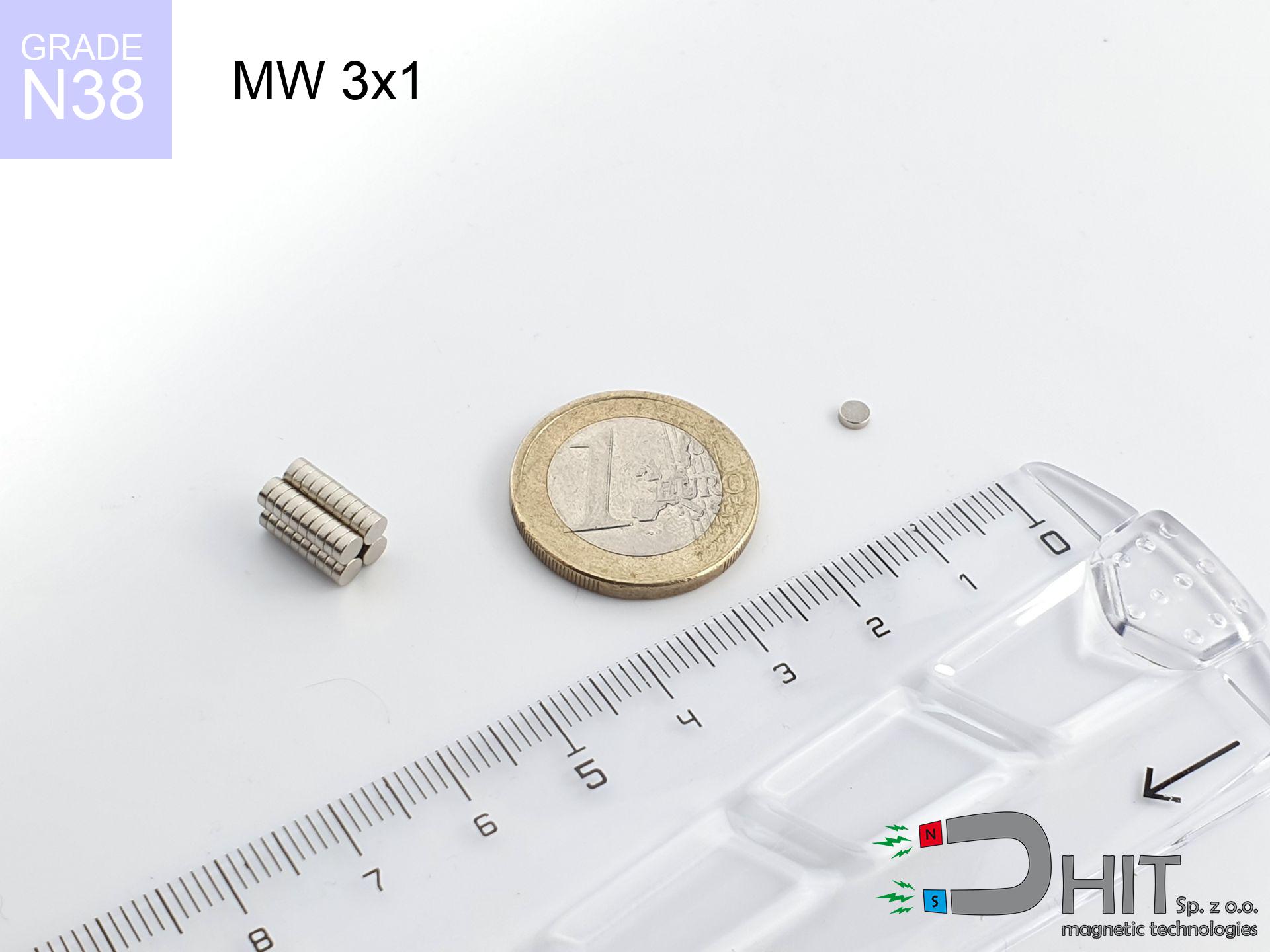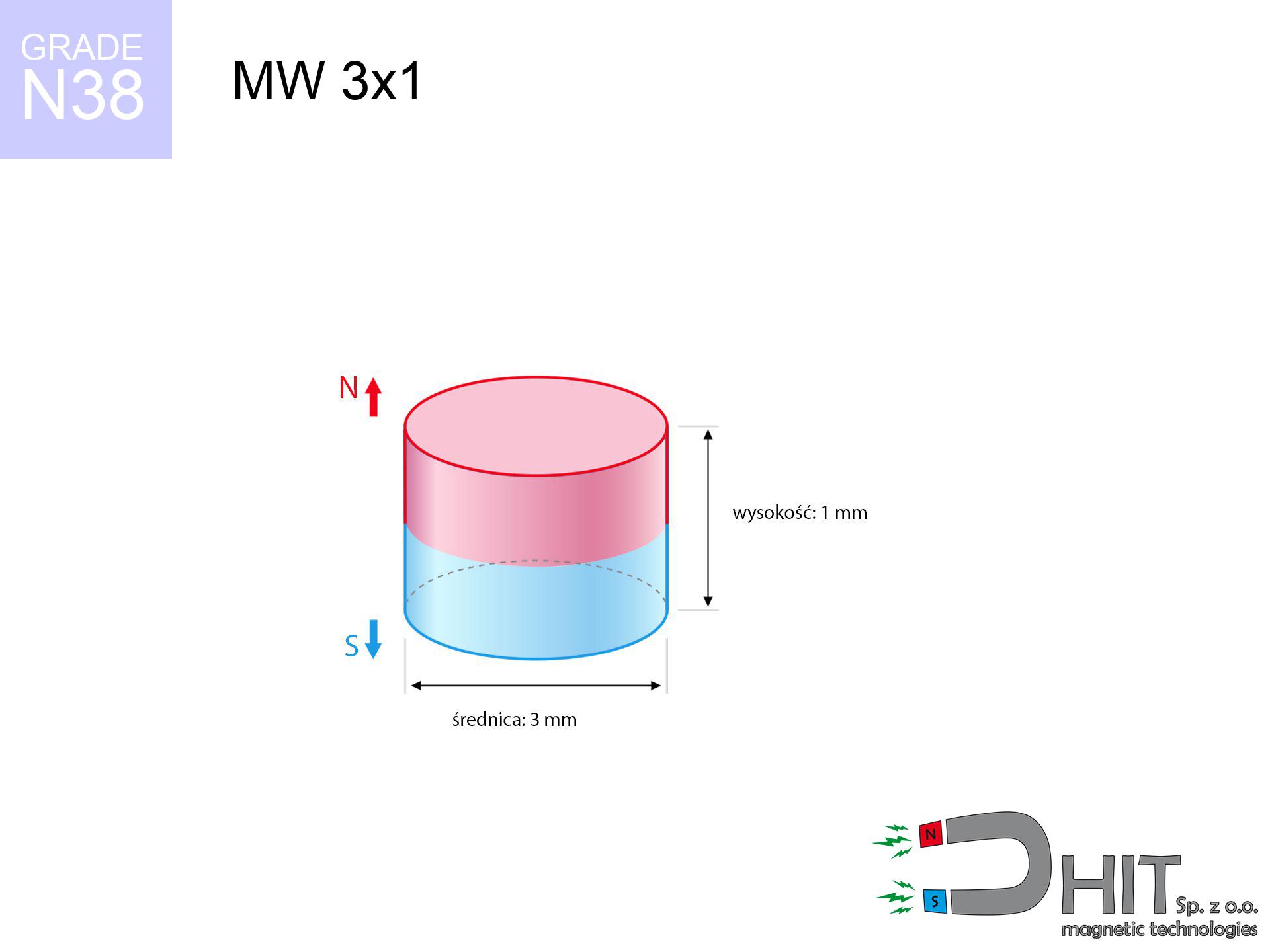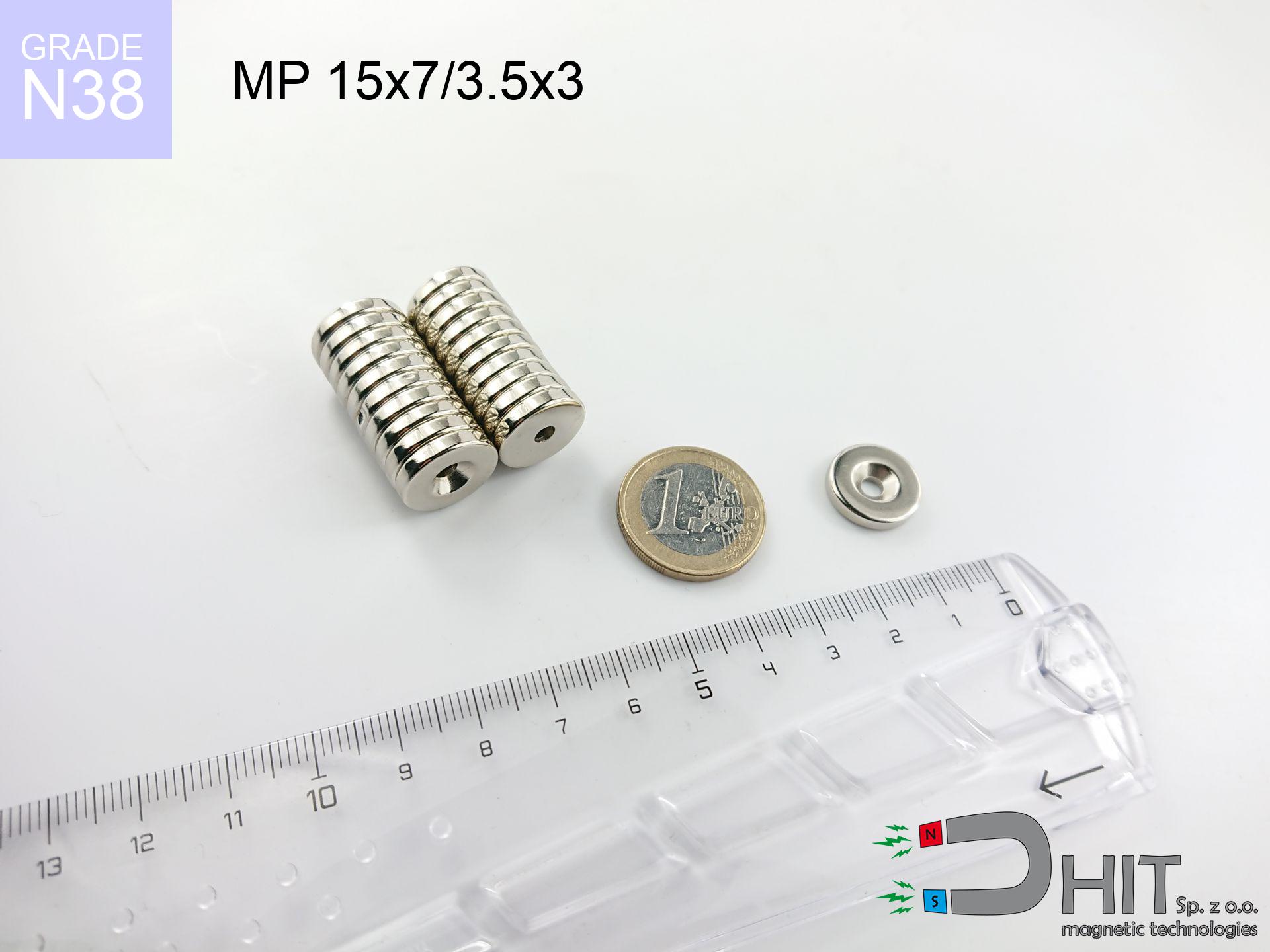MW 3x1 / N38 - neodymium magnet
cylindrical magnet
catalog number 010063
GTIN: 5906301810629
diameter Ø
3
mm [±0,1 mm]
height
1
mm [±0,1 mm]
magnetizing direction
↑ axial
capacity ~
0.17 kg / 1.67 N
magnetic induction ~
342.82 mT / 3,428 Gs
max. temperature
≤ 80
°C
catalog number 010063
GTIN: 5906301810629
diameter Ø
3 mm [±0,1 mm]
height
1 mm [±0,1 mm]
magnetizing direction
↑ axial
capacity ~
0.17 kg / 1.67 N
magnetic induction ~
342.82 mT / 3,428 Gs
max. temperature
≤ 80 °C
0.14 ZŁ gross price (including VAT) / pcs +
0.11 ZŁ net price + 23% VAT / pcs
bulk discounts:
need more quantity?Want to bargain?
Give us a call tel: +48 888 99 98 98 or get in touch through contact form on the contact page. You can check the strength and the shape of neodymium magnet in our magnetic mass calculator power calculator
Orders placed by 2:00 PM will be shipped on the same business day.
Specification: cylindrical magnet 3x1 / N38 ↑ axial
Magnetic properties of the material N38
Physical properties of sintered neodymium magnets Nd2Fe14B
Moreover, even though neodymium is a component of the strongest magnets, they are susceptible to corrosion in humid environments. For this reason, they are coated with a coating of gold to increase their durability. Interestingly that NdFeB neodymium magnets are about 13% lighter than SmCo magnets and, despite their power, easily break, which requires special caution during their handling. For this reason, any mechanical processing should be done before they are magnetized.
In terms of safety, there are many recommendations regarding the use of these magnets. It is advisable to avoid their use in acidic, basic, organic environments or in solvents, as well as in water or oil. Additionally, they can damage data on magnetic cards and hard drives, although data deletion using a neodymium magnet is not guaranteed.
In terms of properties in different environments, neodymium magnets are sensitive to corrosion, especially in humid conditions. Therefore, they are often coated with thin coatings, such as nickel, to shield them from external factors and prolong their durability. High temperatures exceeding 130°C can result in a loss of their magnetic strength, although there are particular types of neodymium magnets that can withstand temperatures up to 230°C.
As for potential dangers, it is important to avoid using neodymium magnets in acidic environments, basic environments, organic or solvent environments, unless they are properly protected. Additionally, their use is not recommended in water, oil, or in an environment containing hydrogen, as they may lose their magnetic strength.
Compilation of suggested goods
Advantages as well as disadvantages of neodymium magnets NdFeB.
Apart from immense strength, neodymium magnets have the following advantages:
- They do not lose strength over time. After 10 years, their strength decreases by only ~1% (theoretically),
- They protect against demagnetization caused by external magnetic field extremely well,
- Thanks to the shiny finish and nickel, gold, or silver coating, they have an aesthetic appearance,
- They exhibit extremely high magnetic induction on the surface of the magnet,
- By using an appropriate combination of materials, they can achieve significant thermal resistance, allowing them to operate at temperatures up to 230°C and above...
- Due to the option of accurate forming or adaptation to individual needs – neodymium magnets can be produced in many variants of shapes and sizes, which expands the range of their possible uses.
- Significant importance in the industry of new technologies – are utilized in computer drives, electric drive mechanisms, medical devices and various technologically advanced devices.
Disadvantages of neodymium magnets:
- They can break when subjected to a powerful impact. If the magnets are exposed to impacts, we recommend using magnets in a steel housing. The steel housing in the form of a holder protects the magnet from impacts and at the same time increases its overall strength,
- High temperatures can reduce the strength of neodymium magnets. Typically, after heating above 80°C, most of them experience a permanent reduction in strength (although it is dependent on the shape and size). To prevent this, we offer special magnets marked with the symbol [AH], which are highly resistant to high temperatures. They can operate even at temperatures up to 230°C, making them an ideal solution for applications requiring high-temperature operation,
- Magnets exposed to a humid environment can corrode. Therefore, when using them outdoors, we recommend using waterproof magnets made of rubber, plastic, or other moisture-resistant materials,
- Limited ability to create threads or complex shapes in the magnet - the use of a housing is recommended - magnetic holder
- Potential hazard to health from tiny fragments of magnets are risky, when accidentally ingested, which becomes significant in the context of child safety. Furthermore, tiny parts of these products have the potential to hinder the diagnostic process in case of swallowing.
Safety Precautions
Neodymium magnets can demagnetize at high temperatures.
Even though magnets have been found to maintain their efficacy up to temperatures of 80°C or 175°F, it's essential to consider that this threshold may fluctuate depending on the magnet's type, configuration, and intended usage.
Under no circumstances should neodymium magnets be brought close to GPS and smartphones.
Magnetic fields can interfere with compasses and magnetometers used in aviation and maritime navigation, as well as internal compasses of smartphones and GPS devices. There are neodymium magnets in every smartphone, for example, in the microphone and speakers.
Neodymium magnets are not recommended for people with pacemakers.
Neodymium magnets generate strong magnetic fields. As a result, they interfere with the operation of a pacemaker. This happens because such devices have a function to deactivate them in a magnetic field.
Neodymium magnetic are especially fragile, resulting in shattering.
Neodymium magnets are extremely delicate, and by joining them in an uncontrolled manner, they will crack. Neodymium magnets are made of metal and coated with a shiny nickel, but they are not as durable as steel. At the moment of collision between the magnets, small metal fragments can be dispersed in different directions.
The magnet coating contains nickel, so be cautious if you have a nickel allergy.
Studies show a small percentage of people have allergies to certain metals, including nickel. An allergic reaction often manifests as skin redness and rash. If you have a nickel allergy, you can try wearing gloves or simply avoid direct contact with nickel-plated neodymium magnets.
It is crucial not to allow the magnets to pinch together uncontrollably or place your fingers in their path as they attract to each other.
Magnets will crack or alternatively crumble with careless joining to each other. You can't move them to each other. At a distance less than 10 cm you should have them extremely firmly.
Neodymium magnets should not be in the vicinity youngest children.
Neodymium magnets are not toys. You cannot allow them to become toys for children. In such a situation, surgery is necessary to remove them. In the worst case scenario, it can result in death.
Under no circumstances should neodymium magnets be placed near a computer HDD, TV, and wallet.
Strong fields generated by neodymium magnets can damage magnetic storage media such as floppy disks, credit cards, magnetic ID cards, cassette tapes, video tapes, or other similar devices. In addition, they can damage televisions, VCRs, computer monitors, and CRT displays. You should especially avoid placing neodymium magnets near electronic devices.
Neodymium magnets are the most powerful magnets ever invented. Their power can surprise you.
On our website, you can find information on how to use neodymium magnets. This will help you avoid injuries and prevent damage to the magnets.
Dust and powder from neodymium magnets are flammable.
Avoid drilling or mechanical processing of neodymium magnets. If the magnet is crushed into fine powder or dust, it becomes highly flammable.
In order for you to know how powerful neodymium magnets are and why they are so dangerous, read the article - Dangerous very powerful neodymium magnets.



![magnetic separator 32x100 [2xM8] / N52 magnetic separator 32x100 [2xM8] / N52](https://cdn3.dhit.pl/graphics/products/sm-32x100-2xm8-war.jpg)

![magnetic separator 32x225 [2xM8] / N52 magnetic separator 32x225 [2xM8] / N52](https://cdn3.dhit.pl/graphics/products/sm-32x225-2xm8-zix.jpg)


